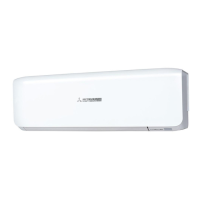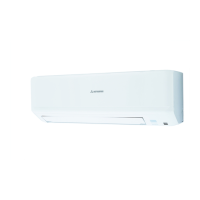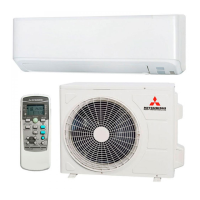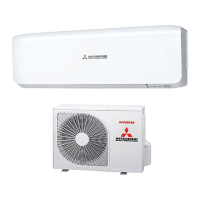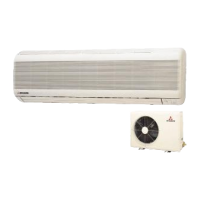Do you have a question about the Mitsubishi SRK25ZD-S and is the answer not in the manual?
| Brand | Mitsubishi |
|---|---|
| Model | SRK25ZD-S |
| Category | Air Conditioner |
| Language | English |
Details the unique characteristics of the "Mitsubishi Daiya" SRK series air conditioners.
Explains the naming convention for the air conditioner models.
Lists the technical specifications for SRK25ZD-S and SRC25ZD-S models.
Provides exterior dimensions for the indoor unit.
Provides exterior dimensions for the outdoor unit.
Shows the electrical wiring diagram for SRK25ZD-S and 35ZD-S.
Explains the functions of the remote control buttons and indicators.
Describes the hot keep operation for preventing cool wind.
Explains the conditions and operation of defrosting.
Details the HI POWER operation for enhanced heating.
Details the HI POWER operation for enhanced cooling.
Describes the control process for cooling oriented dehumidifying.
Describes the control process for heating oriented dehumidifying.
Explains frost prevention during cooling/dehumidifying.
Describes protection for the indoor fan motor.
Explains dew condensation prevention during cooling.
Details measures for oil return to the compressor.
Describes compressor protection during start-up.
Explains the low load starting procedure.
Prevents rapid compressor cycling during operation.
Monitors and controls current to prevent overloads.
Protects the inverter from overcurrent.
Protects against overheating during heating.
Protects against overheating during cooling.
Protects against freezing during cooling/dehumidifying.
Prevents compressor damage from overheating.
Protects against errors in indoor-outdoor signal transmission.
Prevents high pressure during heating operation.
Essential safety guidelines for installation and usage.
Guidelines for selecting the indoor unit installation location.
Guidelines for selecting the outdoor unit installation location.
Specifies limits for piping length and height difference.
Instructions for fixing the installation board for the indoor unit.
Details on drilling holes and installing fixture sleeves.
Instructions for preparing the indoor unit for wiring and piping.
Steps for mounting the connecting wires and terminal block.
Instructions on forming the drain pipe for proper drainage.
Guidelines for installing the outdoor unit on a firm base.
Instructions for connecting the wiring between indoor and outdoor units.
Precautions for preparing refrigerant pipes to prevent contamination.
Details on connecting gas and liquid side piping using a torque wrench.
Procedure for purging air from the refrigerant system.
Instructions for insulating connecting portions to prevent moisture.
Steps for troubleshooting electrical equipment issues.
Flowchart for troubleshooting when the unit runs but is faulty.
Table detailing error codes, causes, and displays.
How to access and use the service mode for diagnostics.
Tables showing remote controller settings and display patterns in service mode.
Tables showing remote controller settings and display patterns in service mode.
Table showing sensor values displayed during error codes.
Table showing sensor values displayed during error codes.
Table showing discharge pipe temperatures and corresponding sensor readings.
Steps to diagnose and fix thermistor errors.
Steps to diagnose and fix current cut issues.
Steps to diagnose and fix outdoor unit errors.
Steps to diagnose and fix compressor overheat issues.
Steps to diagnose and fix serial signal transmission errors.
Steps to diagnose and fix indoor fan motor errors.
Steps to diagnose and fix rotor lock issues.
Steps to diagnose and fix outdoor fan motor errors.
Describes phenomena related to thermistor shortcircuits or wire breaks.
Phenomena for indoor unit thermistors and humidity sensor.
Phenomena for outdoor unit thermistors.
Key checks for the outdoor unit's electrical components.
How to test the electronic expansion valve for voltage.
How to check the resistance value of the discharge pipe thermistor.
How to inspect the input to the Printed Circuit Board (PCB).
How to inspect the serial signal transmission.
Procedure for purging impurities from the refrigerant equipment using a vacuum pump.
Steps for charging the correct amount of refrigerant into the system.
General outline and introduction to the R410A manual.
Details on the adoption and chemical characteristics of R410A refrigerant.
Details on the adoption and chemical characteristics of R410A refrigerant.
Explains the composition changes and characteristics of R410A.
Discusses the pressure characteristics of R410A compared to R22.
Information on suitable lubricating oils for R410A systems.
Details on copper pipes and joints suitable for R410A.
Specifies requirements for copper pipes used with R410A.
Details on flare and socket joints for refrigerant piping.
Details on flare and socket joints for refrigerant piping.
Information on socket joints, including minimum thicknesses.
Steps and precautions for flare processing of pipes.
Detailed instructions and dimensions for flare processing.
Detailed instructions and dimensions for flare processing.
Details on the R410A specific flare tool.
Use of a gauge for adjusting flare projection.
Importance of using the correct vacuum pump adapter.
Identification and purpose of R410A specific refrigerant cylinders.
Requirements for charge ports and packing.
Lists general tools required for installation and servicing.
Table showing R410A tools applicable to R22 models.
Procedure for air purging and gas leakage checks using a vacuum pump.
Procedure for additional refrigerant charging based on piping length.
Steps for recovering refrigerant and removing the unit.
Steps for recovering refrigerant and removing the unit.
Procedure for recovering refrigerant via pump down.
Steps for disconnecting and removing the indoor/outdoor units.
Instructions for installing the unit, referencing previous section.
General procedures for recovering refrigerant.
Checks needed before starting refrigerant recovery.
Steps to check the refrigerant recovering equipment.
Steps to check accessories for the recovery equipment.
Preparations needed before recovering refrigerant.
Preparations needed before recovering refrigerant.
Guidelines for installing the refrigerant recovering equipment.
Guidelines for preparing the refrigerant recovering cylinder.
Connecting the recovery equipment to power.
Preparations for the air conditioner before recovery.
Steps to connect the air conditioner to the recovery equipment.
Information on types and usage of recovering cylinders.
Information on using a drier for R410A recovery.
Information on connection hoses for recovery.
Importance and usage of the gauge manifold.
Information on using tube piercing valves.
Use of the vacuum pump in recovery operations.
